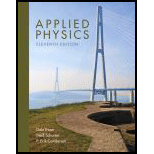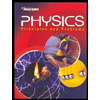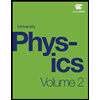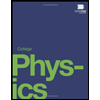
Applied Physics (11th Edition)
11th Edition
ISBN: 9780134159386
Author: Dale Ewen, Neill Schurter, Erik Gundersen
Publisher: PEARSON
expand_more
expand_more
format_list_bulleted
Concept explainers
Textbook Question
Chapter 17, Problem 40RP
What is the cost to operate the lamp in Problem 39 for 135 h if the cost of energy is S
$0.05/kWh?
Expert Solution & Answer
Want to see the full answer?
Check out a sample textbook solution
Students have asked these similar questions
1000 w heater is used 6 hours daily and the cost of 1 unit of electricity is 40 p. how much will it cost in the month of November?
How much does it cost to operate a 104-W device continuously for a week if the power utility rate is 0.30 ¢/kWh? Give your answer in cents.
find the conversion between joule and kWh
How much does it cost to operate a 1200-W hair dryer for 4 hours at 30 cents/kWh ?
Chapter 17 Solutions
Applied Physics (11th Edition)
Ch. 17.3 - Two identical charges, each -8.0010-5C are...Ch. 17.3 - The force of repulsion between two identical...Ch. 17.3 - A charge of +3 010-6C exerts a force of 940 N on a...Ch. 17.3 - A charge of -3.010-8 C exerts a force of 0 045 N...Ch. 17.3 - When a -9.0-C charge is placed 0.12 cm from a...Ch. 17.3 - How far apart are two identical charges of +6.00 C...Ch. 17.3 - Three charges are located along the x-axis. Charge...Ch. 17.3 - Three charges are located along the x-axis Charge...Ch. 17.4 - An electric field has a positive test charge of...Ch. 17.4 - What is the field magnitude of an electric field...
Ch. 17.4 - An electric field exerts a force of 2 5010-4 N on...Ch. 17.4 - An electric field exerts a force of 3.0010-4 N on...Ch. 17.4 - An electric field of magnitude 0.450 N/C exerts a...Ch. 17.4 - An electric field of magnitude 0.370 N/C exerts a...Ch. 17.4 - What force is exerted on a test charge of 3.8610-5...Ch. 17.4 - What force is exerted on a test charge of 4.0010-5...Ch. 17.5 - Prob. 1PCh. 17.5 - Find the resistance of 315 ft of No. 24 copper...Ch. 17.5 - Prob. 3PCh. 17.5 - Prob. 4PCh. 17.5 - Prob. 5PCh. 17.5 - Prob. 6PCh. 17.5 - Prob. 7PCh. 17.5 - Prob. 8PCh. 17.5 - Prob. 9PCh. 17.5 - Find the length of a copper wire with resistance...Ch. 17.6 - A heating element operates on 115 V. If it has a...Ch. 17.6 - Prob. 2PCh. 17.6 - Prob. 3PCh. 17.6 - A heating coil operates on 220 V. If it draws 15.0...Ch. 17.6 - Find the resistance that draws 0.750 A on 115 V.Ch. 17.6 - What current does a75.0- resistance draw on 115 V?Ch. 17.6 - A heater operates on 220 V If it draws 12.5 A,...Ch. 17.6 - What current does a 50.0- resistance draw on 115...Ch. 17.6 - What current does a 175- resistance draw on 220VCh. 17.6 - A heater draws 3.50 A on 115 V. What is its...Ch. 17.6 - (a) What current does a 150- resistance draw on a...Ch. 17.6 - Prob. 12PCh. 17.6 - Electric characteristics of all consumer electric...Ch. 17.6 - What is the effective resistance of a television...Ch. 17.6 - Find the current used by a stereo with resistance...Ch. 17.6 - What is the current used by a microwave oven with...Ch. 17.7 - Three resistors of 2.00, 5.00, and 6.50 are...Ch. 17.7 - Find the current in Problem 1.Ch. 17.7 - Find the equivalent resistance in the circuit...Ch. 17.7 - Find the current through R2 in Problem 3 Figure...Ch. 17.7 - Find the current in the circuit shown in Fig....Ch. 17.7 - Find the voltage drop across R1 in Problem 5...Ch. 17.7 - What emf is needed for the circuit shown in Fig....Ch. 17.7 - Find the voltage drop across R3, in Problem 7...Ch. 17.7 - Find the equivalent resistance in the circuit...Ch. 17.7 - Find R3, in the circuit in Problem 9. Figure 17.34Ch. 17.7 - Find the values of R1. R2 and R3 in Fig. 17.35...Ch. 17.7 - Find the values of V1, R2, and V3 in Fig. 17.36....Ch. 17.7 - Find the values of R1, V2, and R3 in Fig. 17.37....Ch. 17.8 - (a) Find the equivalent resistance in the circuit...Ch. 17.8 - (a) Find l2 (currant through R2) in the circuit...Ch. 17.8 - (a) Find the resistance off R3 in the circuit in...Ch. 17.8 - (a) What is the equivalent resistance in the...Ch. 17.9 - (a) Which resistances are connected in parallel?...Ch. 17.9 - Prob. 2PCh. 17.9 - Prob. 3PCh. 17.9 - Find the voltage drop across R1. Figure 17.55Ch. 17.9 - Prob. 5PCh. 17.9 - What is the equivalent resistance of the...Ch. 17.9 - Prob. 7PCh. 17.9 - Prob. 8PCh. 17.9 - What is the voltage drop across the parallel part...Ch. 17.9 - Prob. 10PCh. 17.9 - Find the current through R5. Figure 17.56Ch. 17.9 - What is the voltage drop across R3? Figure 17.56Ch. 17.9 - Prob. 13PCh. 17.9 - Find the equivalent resistance of the parallel...Ch. 17.9 - Prob. 15PCh. 17.9 - What emf is required for the given current flow in...Ch. 17.9 - Find the voltage drop across the parallel...Ch. 17.9 - Find the voltage drop across R4. Figure 17.57Ch. 17.9 - Find the voltage drop across R6. Figure 17.57Ch. 17.9 - Prob. 20PCh. 17.9 - Figure 17.58 Use Fig. 17.58 in Problems 21 through...Ch. 17.9 - Find the current through R5. Figure 17.58 Use Fig....Ch. 17.9 - Find the voltage drop across R5. Figure 17.58 Use...Ch. 17.9 - Find the voltage drop across R4. Figure 17.58 Use...Ch. 17.9 - Find the current through R2. Figure 17.58 Use Fig....Ch. 17.10 - Prob. 1PCh. 17.10 - Prob. 2PCh. 17.10 - Prob. 3PCh. 17.10 - Prob. 4PCh. 17.10 - Prob. 5PCh. 17.10 - Prob. 6PCh. 17.10 - Prob. 7PCh. 17.10 - Prob. 8PCh. 17.10 - Prob. 9PCh. 17.10 - Prob. 10PCh. 17.10 - Prob. 11PCh. 17.12 - A cell has an emf of 1.50 V and an internal...Ch. 17.12 - Prob. 2PCh. 17.12 - The emf of a battery is 12 0 V. If the internal...Ch. 17.12 - Prob. 4PCh. 17.12 - Prob. 5PCh. 17.12 - Find the current in the circuit shown in Fig....Ch. 17.12 - Find the current in the circuit shown in Fig....Ch. 17.12 - Prob. 8PCh. 17.12 - Find the current in the circuit shown in Fig. 17...Ch. 17.12 - Find the total resistance in the circuit shown in...Ch. 17.13 - A heater draws 8.70 A on a 110-V line. What is its...Ch. 17.13 - What power is needed for a sander that draws 3.50...Ch. 17.13 - How many amperes will a 75.0-W lamp draw on a...Ch. 17.13 - Prob. 4PCh. 17.13 - How many amperes will a 750-W lamp draw on a 110-V...Ch. 17.13 - Find the cost to operate the lamp in Problem 5 for...Ch. 17.13 - Six 50.0-W bulbs are operated for 25.0 h on a...Ch. 17.13 - A small furnace uses 3.00 kW of power. If the cost...Ch. 17.13 - Will a 20.0-A fuse blow if a 1000-W hair dryer, a...Ch. 17.13 - How long could you operate a 1000-W soldering iron...Ch. 17.13 - Prob. 11PCh. 17.13 - Prob. 12PCh. 17.13 - Find the cost of operating a 3.00-A motor on a...Ch. 17.13 - How many amperes will a 60-W lamp draw on a 110-V...Ch. 17.13 - Using the following table, list two different...Ch. 17.13 - Using the preceding table, list two different...Ch. 17.13 - Find the power output of a cell phone charger that...Ch. 17.13 - A power supply for electronic devices delivers...Ch. 17.13 - At what rate does a light bulb convert electric...Ch. 17.13 - What power is used by a light that draws 2.00 A...Ch. 17.13 - How much electric energy (in joules) is delivered...Ch. 17.13 - A car has a 12.0-V battery. If the current through...Ch. 17.13 - (a) How much power does a television use if it...Ch. 17.13 - Prob. 24PCh. 17.13 - A digital timer is used on a 115-V line. (a) If...Ch. 17.13 - A current of 230 A is delivered to a truck starter...Ch. 17.13 - A job site generator delivers 205 A in 15.0 s in a...Ch. 17 - The atomic particle that carries a positive charge...Ch. 17 - The atomic particle that carries a negative charge...Ch. 17 - The process by which an object becomes charged...Ch. 17 - The process by which an object becomes permanently...Ch. 17 - The resistance of a wire is dependent on all of...Ch. 17 - Which of the following are good electric...Ch. 17 - The total resistance in a circuit containing...Ch. 17 - The current in a parallel circuit is given by a....Ch. 17 - The emf of a battery with cells connected in...Ch. 17 - The current in a battery with cells connected in...Ch. 17 - The current in a battery with cells connected in...Ch. 17 - Examples of dry cells include. a. lead-zinc cells....Ch. 17 - In your own words, describe how materials can...Ch. 17 - What particles make up an atom?Ch. 17 - What particles are located in the nucleus (center)...Ch. 17 - Where are electrons located in an atom?Ch. 17 - What are the two types of charge? What atomic...Ch. 17 - Describe the process of charging an electroscope...Ch. 17 - Describe the process of charging an electroscope...Ch. 17 - In your own words, describe Coulombs law of...Ch. 17 - Describe an electric field.Ch. 17 - Describe lightning.Ch. 17 - The flow of electrons through a conductor is...Ch. 17 - (a) The unit of current is the ______. (b) The...Ch. 17 - What effect does doubling the diameter of a wire...Ch. 17 - In your own words, explain Ohm s law.Ch. 17 - Differentiate between a series and a parallel...Ch. 17 - Differentiate between the equivalent resistance in...Ch. 17 - In using an electric instrument, with what range...Ch. 17 - Explain how a parallel water system compares to a...Ch. 17 - How does the current change in a circuit if the...Ch. 17 - How does the current change in a circuit if the...Ch. 17 - How would the resistance of a wire change if the...Ch. 17 - Explain the concept of electric potential.Ch. 17 - Explain the transfer of energy that occurs in a...Ch. 17 - Distinguish between a primary and a secondary...Ch. 17 - Explain recharging.Ch. 17 - Describe the function of an electrolyte.Ch. 17 - In your own words, describe the manner in which a...Ch. 17 - What is the effect of the internal resistance of a...Ch. 17 - The unit of electric power is the ____________.Ch. 17 - In your own words, explain the relationship among...Ch. 17 - Do we pay the utility company for our power use or...Ch. 17 - Explain the relationship among power, voltage, and...Ch. 17 - If the current in a circuit is increased by a...Ch. 17 - If the resistance in a circuit decreases by a...Ch. 17 - If the voltage and current in a circuit each...Ch. 17 - If the current increases in a circuit by a factor...Ch. 17 - Two charges, each -4.50 C, are 0.150 cm apart....Ch. 17 - The repulsive force between two identical negative...Ch. 17 - A charge of 2.50 10-8 C exerts a force of 0.0250...Ch. 17 - A positive test charge of 2.50 C is placed in an...Ch. 17 - Find the magnitude of the electric field in which...Ch. 17 - What force is exerted on a test charge of 4.25 ...Ch. 17 - Prob. 7RPCh. 17 - Prob. 8RPCh. 17 - Prob. 9RPCh. 17 - Prob. 10RPCh. 17 - Find the cross-sectional area of copper wire at...Ch. 17 - A heating element operates on 115 V. If it has a...Ch. 17 - A heating coil operates on 220 V. If it draws 8.75...Ch. 17 - What current does a 234- resistance draw on 115 V?Ch. 17 - Four resistors of 3.40 , 6.54 , 8.32 , and 1.34 ...Ch. 17 - Find the current in Problem 15.Ch. 17 - Find the emf in the circuit shown in Fig. 17.78....Ch. 17 - Find the equivalent resistance in the circuit...Ch. 17 - Prob. 19RPCh. 17 - Find the equivalent resistance in the circuit...Ch. 17 - Find the current in Fig. 17 80. Figure 17.80Ch. 17 - Find the current through R1 in Fig. 17.80. Figure...Ch. 17 - Find the current through R2 in Fig. 17.80. Figure...Ch. 17 - Prob. 24RPCh. 17 - Find the current through R3 in Fig. 17.81. Figure...Ch. 17 - Find the current through R1 in Fig. 17.81; through...Ch. 17 - Find the equivalent resistance in Fig. 17.82....Ch. 17 - Prob. 28RPCh. 17 - Find the voltage drop across R5 in Fig. 17.82....Ch. 17 - Prob. 30RPCh. 17 - Find the voltage drop across R1 in Fig. 17.82....Ch. 17 - Figure 17.83Ch. 17 - A cell has an emf of 1.44 V and an internal...Ch. 17 - Prob. 34RPCh. 17 - Prob. 35RPCh. 17 - Find the current in the circuit shown in Fig....Ch. 17 - Find the total resistance in the circuit shown in...Ch. 17 - What power is needed for a drill that draws 2.45 A...Ch. 17 - How many amperes will a 150-W light bulb draw on a...Ch. 17 - What is the cost to operate the lamp in Problem 39...Ch. 17 - If the cost of energy is 0.043/kWh, how long could...Ch. 17 - How many amperes will a 10-W lamp draw on a 110-V...Ch. 17 - A hydrogen atom contains one electron and one...Ch. 17 - A rod with charge -4.31 10-8 C is held 10 3 cm...Ch. 17 - Hairdryers work by blowing heat that is generated...Ch. 17 - A 1000-W microwave, a 40.0-W fluorescent light...Ch. 17 - A 700-W toaster is plugged into a 110-V outlet....
Additional Science Textbook Solutions
Find more solutions based on key concepts
15. (II) The gauge pressure in each of the four tires of an automobile is 240 kPa. If each tire has a “footprin...
Physics: Principles with Applications
21. You’re driving your pickup truck around a curve with a radius of 20 m. A box in the back of the truck is pr...
College Physics: A Strategic Approach (4th Edition)
A sample of basalt has a mass of 5.6 g and a volume of 2 cm3. Show that the density of basalt is 2.8 g/cm3.
Conceptual Integrated Science
3. What is free-fall, and why does it make you weightless? Briefly describe why astronauts are weightless in th...
The Cosmic Perspective (8th Edition)
Choose the BEST answer to the question or the BEST way to complete the statement.
1. Water pressure at the bott...
Conceptual Physical Science (6th Edition)
The normal force of the log on the frog.
College Physics: A Strategic Approach (3rd Edition)
Knowledge Booster
Learn more about
Need a deep-dive on the concept behind this application? Look no further. Learn more about this topic, physics and related others by exploring similar questions and additional content below.Similar questions
- The average television is said to be on 6 hours per day. Estimate the yearly cost of electricity to operate 100 million TVs, assuming their power consumption averages 150 W and the cost of electricity averages 12.0 cents/kW h .arrow_forwardA 165F capacitor is used in conjunction with a dc motor. How much energy is stored in it when 119 V is applied?arrow_forwardWith a 1200-W toaster, how much electrical energy is needed to make a slice of toast (cooking time = 1 minute)? At 9.0 cents/kW h, how much does this cost?arrow_forward
- What voltage is involved in a 1.44-kW short circuit through a 0.100- resistance?arrow_forwardIf electricity costs 10.0 cents per kW·h, how much does it cost to operate the device for 9.1 hours? (Give your answer in dollars, but do not include the dollar sign.)arrow_forwardA person used his 1500 W air-conditioning unit for 5 h every day during the month of June. How much did it cost him for using his air conditioner if electricity is priced at P8.17/kWh?arrow_forward
- An electric clothes dryer is rated at 2,000 W. How much energy does it use in 35 min? kWharrow_forwardA refrigerator using 1028 W runs one-third of the time. How much does the electricity cost to run the refrigerator each month (30 days) at 29¢ per kWh?arrow_forwardWhat is the cost of operating a 54.64-W light for a year if the cost of electricity is $0.2 kWper hr ?arrow_forward
- for an electric rate of 8.9071/kwh, what does it cost to live a 60 -W light bulb on for 8hrarrow_forwardIf a power company charges 12 cents per kW.h, then how much does it cost to run a 1500 W hair dryer for 10 minutes?arrow_forwardA utility company charges 8.5 cents/kWh. If a consumer operates a 40-W light bulb continuously forone day, how much is the consumer charged?arrow_forward
arrow_back_ios
SEE MORE QUESTIONS
arrow_forward_ios
Recommended textbooks for you
 Glencoe Physics: Principles and Problems, Student...PhysicsISBN:9780078807213Author:Paul W. ZitzewitzPublisher:Glencoe/McGraw-Hill
Glencoe Physics: Principles and Problems, Student...PhysicsISBN:9780078807213Author:Paul W. ZitzewitzPublisher:Glencoe/McGraw-Hill An Introduction to Physical SciencePhysicsISBN:9781305079137Author:James Shipman, Jerry D. Wilson, Charles A. Higgins, Omar TorresPublisher:Cengage Learning
An Introduction to Physical SciencePhysicsISBN:9781305079137Author:James Shipman, Jerry D. Wilson, Charles A. Higgins, Omar TorresPublisher:Cengage Learning
 College PhysicsPhysicsISBN:9781938168000Author:Paul Peter Urone, Roger HinrichsPublisher:OpenStax College
College PhysicsPhysicsISBN:9781938168000Author:Paul Peter Urone, Roger HinrichsPublisher:OpenStax College

Glencoe Physics: Principles and Problems, Student...
Physics
ISBN:9780078807213
Author:Paul W. Zitzewitz
Publisher:Glencoe/McGraw-Hill

An Introduction to Physical Science
Physics
ISBN:9781305079137
Author:James Shipman, Jerry D. Wilson, Charles A. Higgins, Omar Torres
Publisher:Cengage Learning


College Physics
Physics
ISBN:9781938168000
Author:Paul Peter Urone, Roger Hinrichs
Publisher:OpenStax College
Ohm's law Explained; Author: ALL ABOUT ELECTRONICS;https://www.youtube.com/watch?v=PV8CMZZKrB4;License: Standard YouTube License, CC-BY